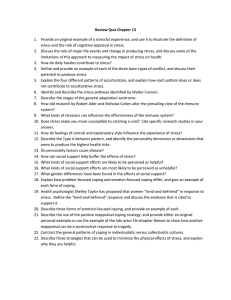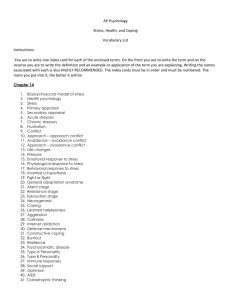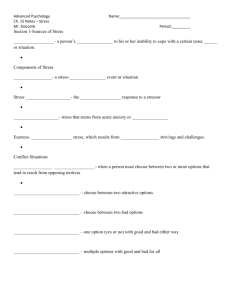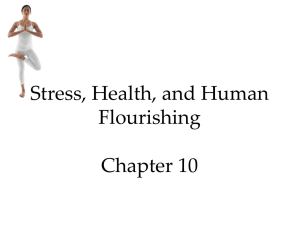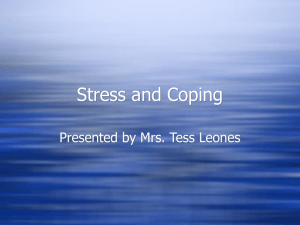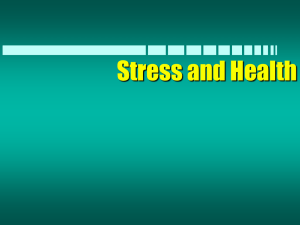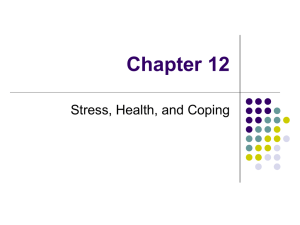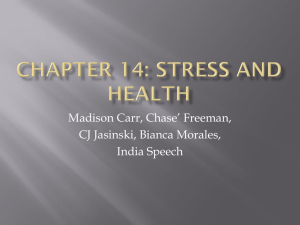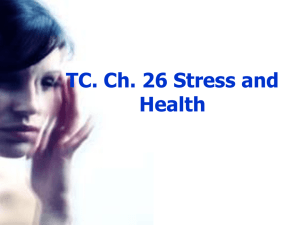cope
advertisement
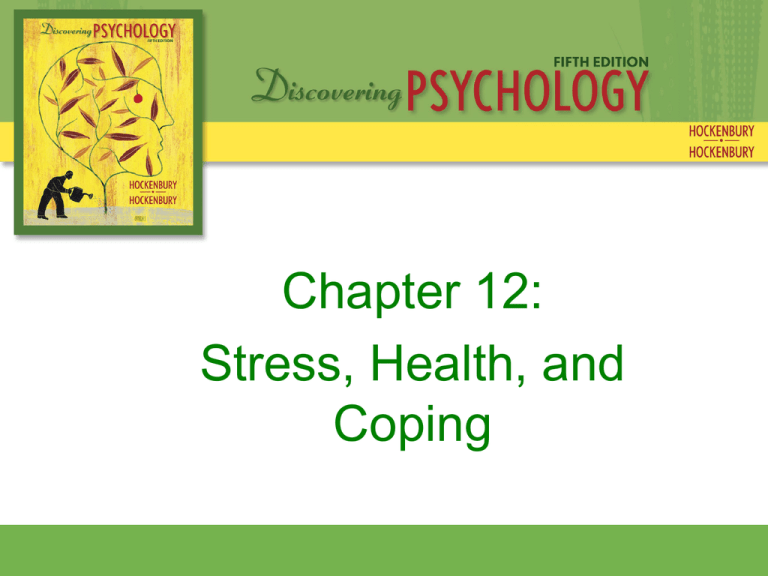
Chapter 12: Stress, Health, and Coping Stress • A negative emotional state in response to events that we perceive as taxing our resources or our ability to cope. • Stressors—events that are perceived as harmful, threatening, or challenging • Daily hassles—everyday minor events that annoy and upset people Biopsychosocial Model of Health • Health psychology—the study of how psychological factors influence health, illness, and health-related behaviors • Biopsychosocial model—the belief that physical health and illness are determined by the complex interaction of biological, psychological, and social factors Life Changes • Change is stressful. – For example, death, marriage, divorce, loss of job, having children, retirement Daily Hassles •Annoying events in everyday life • We all have “bad hair” days; these minor things can add up to lots of stress •Measured by Lazarus and colleagues Social and Cultural Sources of Stress • Social conditions that promote stress – poverty, racism, discrimination, crime – lowest SES tend to have highest levels of stress – Subtle racism called microaggressions Sources of Chronic Stress • Crowding, crime, unemployment, inadequate healthcare, substandard housing • Daily hassles more common in poverty-stricken neighborhoods • People in low SES have higher rates of distress and illness, more stress hormones produced Stress Variables • Women more likely to become upset by negative events, and show more workfamily spillover • Minor stressors can build up and become cumulative. Social and Cultural Sources of Stress Acculturative stress—the stress that results from the pressure of adapting to a new culture Health Effects of Stress • Indirect effects promote behaviors that jeopardize physical well being; use of drugs, lack of sleep, poor concentration • Direct effects promote changes in body functions, leading to illness such as headaches and other physical symptoms Endocrine Responses to Stress • Fight or flight preparation of body-first described by Walter B. Cannon • Stress hormones—produced by adrenal glands – Adrenal medulla—catecholamines • Epinephrine and norepinephrine • Increases respiration, BP, heart rate – Adrenal cortex—corticosteroids • Release stored energy • Reduces inflammation and immune system responses General Adaptation Syndrome • Hans Selye • Three-stage process Alarm—intense arousal, mobilization of physical resources (catecholamines) Resistive—body actively resists stressors (corticosteroids) Exhaustion—more intense arousal but this leads to physical exhaustion and physical disorders General Adaptation Syndrome Stress Resistance Phase 1: Alarm Reaction Phase 2: Resistance (cope) Phase 3: Exhaustion Stress and the Immune System • Psychoneuroimmunology—studies interaction between nervous system, endocrine system, and immune system • Stress leads to suppressed immune function • Chronic stress tends to have more influence • A stress-weakened immune system increases likelihood of illness. Your immune system battles bacteria, viruses, and other foreign invaders that try to set up housekeeping in your body. The specialized white blood cells that fight infection are manufactured in the bone marrow and are stored in the thymus, spleen, and lymph nodes until needed. How stressors influence immune system • Glaser studies on how stress affects immune system functioning – Stress of exams lowers ability to heal • Cohen study on relationship between stress and infection – Greater susceptibility to infection by a cold virus when chronically stressed How stressors influence immune system • Confirms Selye’s findings that chronic stress triggers secretion of corticosteroids. • Compromises immune system functioning • Higher self-perceptions of stress in women lead to poorer response to HPV vaccine Response to Stress • Psychological Factors – Perception of control – Explanatory style – Chronic negative emotions – Hostility • Social Factors – Outside resources – Friends and family – Positive relationships Perceived Control • Sense of control decreases stress, anxiety, and depression • Perceptions of control must be realistic to be adaptive Perceptions of Control: Social Status • Perception of one’s own social status shown to influence physical effects of stress. • Despite being the same in social status, people who view themselves low in social status have higher rates of infection than those who view themselves higher (Cohen, 2009) Explanatory Style • Optimism – use external, unstable, and specific explanations for negative events – predicts better health outcomes • Pessimism – use internal, stable, and global explanations for negative events – predicts worse health outcomes Stress, Personality, and Heart Disease • Habitually grouchy people tend to have poorer health outcomes. • Chronic negative emotions have a negative effect on immune system. • Those who are more anxious, depressed, angry and hostile more likely to develop arthritis and heart disease. Type A vs. Type B Personality • Type A – react more intensely to stressors – time urgency – intense ambition and competitiveness – general hostility – associated with heart disease • Type B – more easygoing – not associated with heart disease Research on Type A Personality • Time urgency and competitiveness not associated with poor health outcomes. • Negative emotions, anger, aggressive reactivity • High levels of hostility increase chance of all disease (eg, cancer) Social Networks Those with diverse social networks shown to have: – greater resistance to upper respiratory infections – lower incidence of stroke and cardiovascular disease among high-risk women – decreased risk for recurrence of cancer – lower incidence of dementia “Diverse social networks” includes different types of relationships – Being married – Having different types of close relationships – Belonging to social, political, religious groups Social Factors Promoting Health Social support—resources provided by others in times of need • Emotional—expressions of concern, empathy, positive regard • Tangible—direct assistance, such as lending money, providing meals • Informational—such as making good suggestions, advice, good referrals Social Support • Improves ability to cope with stress and benefits health – person modifies appraisal of stressor’s significance to be less threatening – helps to decrease intensity of physical reactions to stress – make person less likely to experience negative emotions • Pets as social support – especially for elderly and people who live alone • Gender and social support Coping Behavioral and cognitive responses used to deal with stressors; involves efforts to change circumstances, or our interpretation of them to make them more favorable and less threatening. Coping • Problem-focused coping – – – – managing or changing the stressor use if problem seems alterable confrontive coping planful problem solving • Emotion-focused coping – try to feel better about situation – use if problem out of our control Emotion-Focused Coping Strategies • Escape-avoidance—try to escape stressor • Distancing—minimize impact of stressor • Denial—refuse to acknowledge problem exists Emotion-Focused Coping Strategies • Wishful thinking—imagining stressor is magically gone • Seeking social support—turn to friends, support people • Positive reappraisal—minimize negative, emphasize positive • Downward comparison—compare self with those less fortunate Gender Differences in Stress – Physiologically • similar in terms of “fight-or-flight” response – Behaviorally • women and men differ • women follow “tend and befriend” pattern • men tend to withdraw more • said to be adaptive Culture and Coping – Individualist • less likely to seek social support • favor problem-focused coping – Collectivist • more oriented toward social support • favor emotion-focused coping Active Coping Strategies • Aerobic exercise can reduce stress, depression, and anxiety. • More effective than relaxation treatment. Meditation and Relaxation • Meditation can lower blood pressure, heart rate, and oxygen consumption. • Possibly helps stress-related symptoms Meditation and Relaxation – Mindfulness meditation is one technique, adapted by modern clinicians to use in a secular context. • Mindfulness refers to an approach to everyday life as well as a formal meditation technique. • focusing awareness on present experience with acceptance, in a nonjudgmental, non-reactive manner. • idea is that most psychological distress is caused by a person’s reactions to events and circumstances. • proposed to foster clear thinking and open-heartedness. • a way to correct that habitual perspective, clearing and calming the mind in the process. Relaxation Techniques • Focus mental attention, heighten awareness, and quiet internal chatter. • Practiced sitting quietly, sometimes with movement. • Get comfortable, in a quiet place, sit relaxed yet upright and alert. Eyes closed, allow muscles to slowly relax. • Focus attention on your breath as your primary object of attention, while noting whatever else arises in the field of awareness. • Begin with a short, easily attainable goal, such as meditating for five minutes without taking a break, and slowly increase time.
